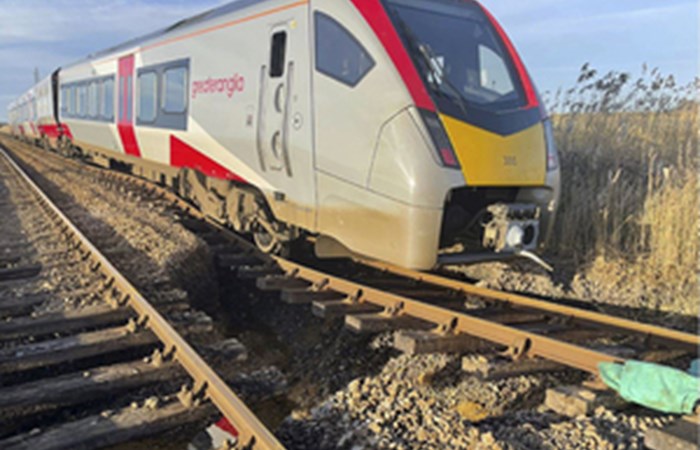Rail Accident Investigation Branch

Summary
At about 07:45 hrs on Sunday 30 January 2022, a passenger train, which was travelling from Norwich to Lowestoft, ran on to a washed out section of track between Reedham and Haddiscoe stations. The train, which was crewed by a driver and a guard, was carrying five passengers. The driver had seen that the track was flooded ahead of the train and so brought it to a stand. Once the train had stopped, the driver noticed that the ballast was washing away under the train. While the driver was preparing to drive back towards Reedham, the situation worsened and a section of ballast washed away, leaving a large void under the track on which the train was standing. As the driver moved the train it started to lean over. The driver therefore made the decision that it was too dangerous to continue moving the train, and they and the guard evacuated the five passengers.
RAIBs investigation found that unusually high water levels existed on the day of the incident due to a combination of tidal surge and tidal locking. Localised low spots in the flood defences next to the track concerned then allowed this water to enter the railway. The train involved was not prevented from entering the flooded section of track because Network Rail was not aware that water was entering the railway at this location. RAIB also found that Network Rails flood risk management processes were not effective at warning that the track at Haddiscoe was at serious risk of flooding.
Underlying factors were that the Environment Agencys management of flooding risk in the area did not account for, and was not required to account for, the impact of localised flooding on the railway, and that Network Rail was not effectively managing the risks to its assets and services associated with third party flood defences. A possible underlying factor was that no joint strategy was in place to protect the railway from flooding at this location due to the Environment Agency and Network Rail not effectively collaborating.
Recommendations
As a result of the investigation RAIB has made five recommendations. The first is made to the Environment Agency and Network Rail and aims to ensure that railway?related flood risk is managed appropriately alongside Haddiscoe Cut. The second and third recommendations are made to Network Rail and concern the integration of flood risk into their weather management strategies. The fourth recommendation is intended to improve interaction between Network Rail and those organisations responsible for tidal flood defences in England and Wales, while the final recommendation is intended to improve these interactions in Scotland.
Notes to editors
-
The sole purpose of RAIB investigations is to prevent future accidents and incidents and improve railway safety. RAIB does not establish blame, liability or carry out prosecutions.
-
RAIB operates, as far as possible, in an open and transparent manner. While our investigations are completely independent of the railway industry, we do maintain close liaison with railway companies and if we discover matters that may affect the safety of the railway, we make sure that information about them is circulated to the right people as soon as possible, and certainly long before publication of our final report.
-
For media enquiries, please call 01932 440015.

